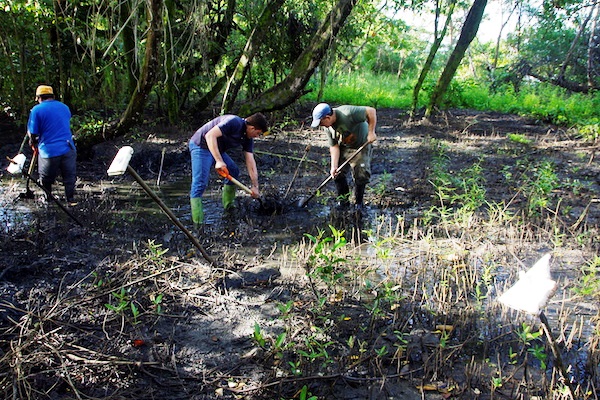In 2009, I volunteered for an organization in Honduras and was once again struck by the beauty of the mangrove ecosystems. Little did I know that I would be working in the Honduran mangroves three years later.
Mangroves are fascinating tree species that provide numerous ecosystem services. Mangroves grow in coastal saline or brackish water in tropical or subtropical regions. They tolerate salt since they are capable of excluding or expelling salt, and they improve water quality by filtering out sediment, excess nutrients and heavy metal ions. They help reduce erosion and protect against extreme weather events and waves. They also store a huge amount of carbon.
Mangroves form the basis of the inshore food-web, as they provide food in the form of leaf debris, algae and bacteria which feeds nearby marine creatures, as well as habitats for a broad spectrum of wildlife. They also provide a home to many endangered species. They serve as important nurseries and feeding grounds for marine life and vital resting sites for millions of migratory birds. In addition, considering the beauty of mangrove ecosystems, they also help the local economy by being ecotourism destinations.
As I coordinated a community resilience and mangrove restoration program in Honduras for Falls Brook Centre, we were confronted with environmental difficulties at one of our project sites that went beyond my knowledge and expertise. In 2014, I thus contacted Alfredo Quarto, Co-Executive Director of the Mangrove Action Project (MAP). MAP aims to design and implement a successful method of restoring mangroves.
MAP’s methodology, Community-Based Ecological Mangrove Restoration (CBEMR), was developed by Robin Lewis. It uses hydrological restoration to facilitate the natural regeneration of mangroves. MAP’s method is successful because it looks at every aspect of a proposed restoration site – its ecology (hydrology, local species, topography) as well as cultural, political and social issues – and is always done with the involvement of the local community.
The need for mangrove restoration in Honduras is urgent. Some areas, such as Barra Cuyamel and Motagua, are losing shoreline at the staggering rate at about 12 meters annually, forcing entire communities to be relocated.
In October 2014, Dominic Wodehouse, the lead CBEMR trainer, and Alfredo Quarto suggested a restoration site in Laguna de Chachahuala, where local fishermen had severely damaged the mangrove forests. We followed MAP’s Community-Based Ecological Mangrove Restoration methodology.
The results were great. Mangroves began to thrive and regenerate naturally. Black and white mangroves predominated. Two and a half years later, mangroves are approximately 4 m high! The ecosystem is healthier. Crabs, birds and fishes are now observed in the previously near-lifeless site.
Photo of mangrove restoration in action by Dominic Wodehouse.
See full article by Mira Maude Chouinard in Positive Planet.

